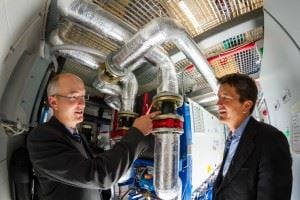The newly built mini-supermarket in Kroppanmarka in Trondheim was opened last autumn by a government minister to the sound of a brass band. Throughout the winter, it used 30 per cent less electricity than four comparable stores in the capital of mid-Norway, where of course the outdoor temperature was the same for all of them.
The Kroppanmarka supermarket has just been awarded Trondheim’s Energy Conservation Prize. The whole energy chain in the store was designed in the course of a research project led by senior scientist Armin Hafner of SINTEF Energy Research. He is convinced that the store is the most energy-efficient example of its type in Norway.
Smart use of daylight and waste heat
“I am quite certain we can put it like that. There is not another free-standing supermarket in Norway whose energy consumption is as low as this,” says Hafner, indicating the interior of the brightly-lit premises, stacked full of food and other necessities.
According to the project manager, the store’s modest appetite for energy is the result of two energy-efficiency strategies:
- Lighting control. An automatic control system switches off the ceiling lights when sufficient daylight enters the premises. Façades made of a transparent aerogel insulation material distribute daylight efficiently throughout the store. Use of this material has also eliminated the need to install expensive sun-blind systems.
- Fully integrated ventilation, refrigeration and heating system. Surplus heat from refrigeration units is temporarily stored in tanks, and when needed is returned to the store via its ventilation and underfloor heating systems. In addition, four 170 metre-deep energy storage wells have been drilled outside the building. These supply energy that can be used for air-conditioning and dehumidifier units in summer, and as additional heat source during the winter months (heat pump mode). There will be no direct use of electricity for heating – an inefficient way of using energy.
“Our secret is that we store the heat that we already have and use it intelligently,” says Hafner.

|
Rema 1000 managing director Ole Robert Reitan visits the refrigeration machine-room in the newly built supermarket with SINTEF’s Armin Hafner. SINTEF/Thor Nielsen |
Next step: series production
These energy solutions were designed as part of the CREATIV competence project, which receives financial support from the Research Council of Norway. Project members include the supermarket chain Rema 1000 and industrial supply companies Danfoss and Systemair. The Snøhetta architectural partnership designed the premises.
None of the partners involved in the concept wishes to hide the fact that the cost of the supermarket was higher than most local stores. Now, scientifically designed energy measurements will lay the foundations for series production designs, thereby lowering the cost of similar solutions. The idea is that the equipment and system manufacturers will employ them in other stores, both in Norway and abroad.
This article is originally published at Gemini.no - Science news from NTNU and SINTEF

